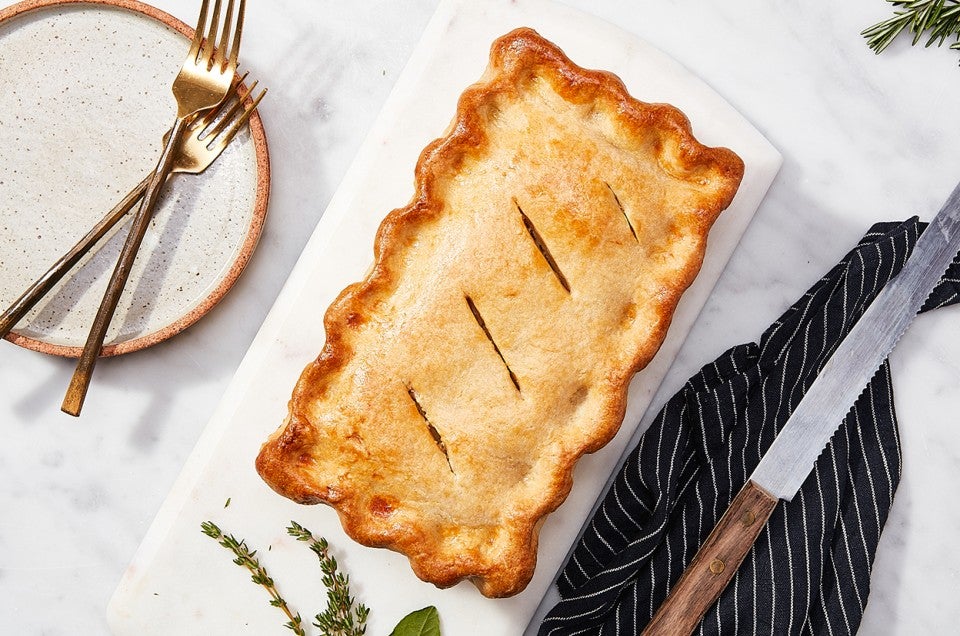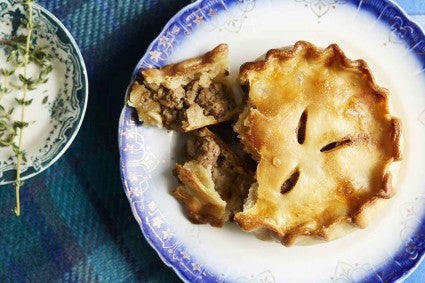Hot water crust breaks all the rules
The method flips everything you know about pies to make a sturdy, simple crust.


Cold, cold, cold.
It’s the mantra of making pie crust. Keep your butter cold, your kitchen cold, and your dough cold — a lesson that’s drilled into bakers since the first time they pick up a rolling pin. That’s because heat is the enemy of a crispy, tender crust, which relies on cold chunks of butter to melt in the oven and create small pockets of flakiness.
But like most rules, there’s one notable exception: hot water pastry. A crust that doesn’t depend on cold butter and uses boiling water, shattering pastry rules everywhere.

Hot water pastry dates back hundreds of years and is descended from British pie-making traditions. Historically, British pies were made in thick, sturdy crusts (referred to as “coffynes” or “coffins”) that were designed mostly as receptacles for the hearty, savory fillings within than pleasant eating experiences on their own. According to food historian Emma Kay, hot water pastry likely evolved “to make the pies which were made in the houses of royalty and nobility a considerable size, and to look striking on the table” and can be traced back to around the early medieval period.
One old mention of this pastry style can be found in The English Huswife, published in London in 1615, which called for hot water to make a “moist, thick, tough, coarse, and long lasting crust” to hold fillings like wild boar, elk, turkey, and lamb, among others. In other words, home cooks have been turning to this trusty crust for a long time!
This hot water method is similar to the Japanese bread-making technique yudane, itself a cousin to the well-known tangzhong method. In each of these baking techniques, hot water (or another liquid, like milk) is combined with flour, which pre-gelatinizes the flour’s starches so they can absorb more liquid. This leads to more moisture in the dough and makes for a softer, smoother dough that’s easy to handle. (Learn more about these methods in our blog post, A closer look at tangzhong.)
As a result, hot water pastry dough is much more pliable than typical pie crust, making it pleasant to roll. There’s little cracking or tearing in the dough, and even if it does split, you can pinch it back together or tear off a section of dough to patch the hole with little issue.

Using hot water doesn’t just affect the way the dough handles; when it bakes, this pastry is thick and sturdy. So sturdy, in fact, that it can hold its shape all by itself, standing tall and straight when it fully emerges from a pie plate or springform pan. And it has no trouble standing up to heavy fillings (hence why historical bakers loved it!). Finally, the baked crust is dense and somewhat hard, with a snappy texture unlike the large, shattering flakes of a cold-butter crust.
Though methods can differ slightly, the basic way to make a hot water crust is to bring water and fat (butter, shortening, suet, and lard all work) to a boil until the fat has melted into the water. The scalding hot mixture is poured into a bowl of flour and salt, then mixed to form a ball of dough.
At this point, you can already start to notice a difference between hot water pastry dough and traditional pie crust dough. The hot water dough has a soft, even consistency that’s a little like Play-Doh. Traditional pie dough, meanwhile, is flaky and slightly shaggy, with visible chunks of butter.
The hot water dough is kneaded a few times (yes, kneaded — another noticeable departure from traditional pie crust) then rolled out while still warm. Next, it’s fitted into your baking vessel of choice to await its ample filling.

While incredibly useful, hot water pastry isn’t something you’d want to substitute for any old pie that calls for a typical crust. That’s because its hard, thick shell is a stark departure from tender crusts and might stand out as unusual alongside traditional pie fillings like baked apples or creamy lemon meringue.
Instead, it’s best suited for pies with dense, heavy fillings — the kind that need a little extra support to hold together neatly. We first debuted a hot water crust on the King Arthur recipe site as part of this Turkey Dinner Pie, a brilliant dish in which this crust becomes a vessel for all the leftovers of a Thanksgiving feast. Now with Christmas around the corner, you can take this as inspiration and pile in your holiday dinner leftovers.
It doesn’t have to be a celebratory meal to use this formula, either. If you have ample leftovers from any meal, try sandwiching them in a hot water crust and invent an entirely new entrée.
Do you bake with hot water pastry? We’d love to hear about it in the comments, below.
Cover photo by Rick Holbrook.

